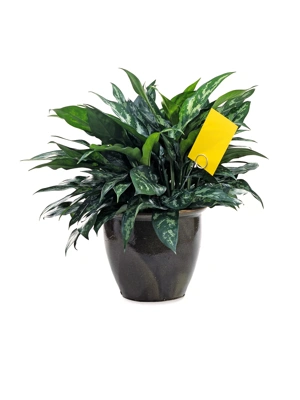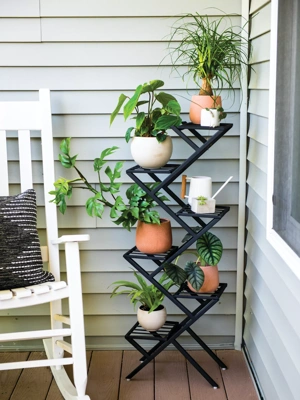What's Your Houseplant Personality?
How to find the right plant for your lifestyle
 All photos by Karina Aldredge.
All photos by Karina Aldredge.Are you a helicopter plant parent? Or do you worry that you have a black thumb? Fear not! I'm here to guide you through a new approach to indoor plant care, one based on houseplant personalities. It's the result of my 20 years of hands-on experience tending to my own houseplants, houseplants of friends, family, clients, and countless virtual plant rescue missions.

Houseplant personalities is a more of a lifestyle approach and less of a how-to, geared toward the health and wellbeing of both the houseplant and you, the plant parent. It's a wonderful way to remove the stress around keeping houseplants thriving, and instead, turn houseplant care into a form of self-care. And we all need more of that in our lives! We just need to find the right plant(s) for your personality and lifestyle and I'm here to help.
The Best Plants for Your Houseplant Personality
Ok, my friend, first question: Are you a nurturer that loves to tend daily to your plant friends? Or are you someone who loves the idea of houseplants all over your home, but remembering to care for them can cause you anxiety instead of that plant therapy you were hoping for?
1. NurturerIf you are the first type of person, a helicopter plant parent who can't wait to wake up in the morning to visit your houseplants between sips of coffee, an adorable vintage mister in one hand and watering can in the other, here are the types of houseplants I suggest for you: |
||
|
|
 |
2. Laid BackIf instead, you realize your houseplants need water because they cry out with droopy, yellow leaves, you may be more in alignment with the second plant personality. Note: I'm here to encourage you to forget the notion of you being a bad plant parent or having a "black thumb." I don't believe there is such a thing as a black thumb. In my experience, all you need is the correct information, some guidance, the right plant for your personality and maybe a calendar to remind you. If that sounds like you, I encourage you to try out a houseplant or two from these categories: |
||
|
|
 |
|
Note: Be sure you have plenty of light for cacti, succulents, and euphorbia before acquiring. What they lack in watering demand, they make up for in lighting needs. I suggest a minimum of four hours a day in a brightly lit window or exposure from a skylight or a grow light, especially during the winter months, to keep them thriving in your home. That amount of light keeps your succulents and cacti happiest and encourages them to hold their unique shape without becoming distorted in a desperate attempt to reach for more light. If you have experienced those little green arms stretching out to grab at the sunlight, you understand what I mean. |
||
3. In BetweenIf you're like me, you fall somewhere in between those two houseplant personalities. You can acquire a variety of houseplants and easily dabble in anything I have suggested. I have an additional, third category of houseplants for you too! The following prefer a weekly (ish… 7-10 days) schedule of watering and monthly feeding during the spring, summer, and fall: |
||
|
|
 |
|
Marimo moss balls are an aquatic plant (actually an alga) that thrive in weekly water changes and indirect light. I don't feed them per se, but I do add carbonated water to their vase every month (to boost oxygen and increase photosynthesis) and an occasional pinch of aquarium or sea salt, too. Scroll down to the Resources section for links to my blog post and tutorials about merimo moss balls. |
||

Matching Pots to Plants
Ok, now that we've established what kind of plant personality you are, let's talk about what kind of pot or vessel best fits your personality. Three of the most common vessels are: porous terra-cotta pots, glazed ceramic planter, and vintage/unique containers with no drainage.
Terra cotta: Unglazed terra cotta pots are porous and wick moisture away from the soil, making them wonderful vessels for cacti and succulents. They can also be a perfect fit for the over-nurturer houseplant personality, as it is very tricky to overwater a plant when it's housed in a well-draining terra cotta vessel.
Glazed ceramic: Glazing renders a ceramic pot non-porous. This helps retain moisture in the soil for longer, so they are a perfect match for water-loving houseplants like calathea, maranta, papyrus, and ferns (and a good match for the under-nurturer personality).
Vintage vessels with no drainage: If you have a lovely heirloom vessel or unique container but it lacks drainage holes to allow excess water to drain, you have a few choices.
- Use it as a cachepot. Reuse a slightly smaller nursery pot with drainage holes that will nestle nicely inside the outer decorative pot, called a cachepot. (If the inner pot shows you can use moss to hide it or use scissors to trim away the top edge.) After each watering, empty any water that has drained into the cachepot. Be sure to use a saucer to protect surfaces if the bottom of the cachepot is rough or unglazed (which allows moisture to pass through).
Sustainable Tip: I have found old plates or plastic yogurt lids to be excellent repurposed saucers. - Plant directly into the pot. It's more challenging, but not impossible, to plant directly into a pot with no drainage because you'll need to be extra-careful not to overwater. This method generally takes time and experience to master, but if you are up for the challenge, I'm happy to guide you through my process. For a how-to, scroll down to the Resources section for a link to my blog post.
I hope this guidance encourages you in all of your houseplant endeavours, my friends!
Resources
You'll find more houseplant resources on Karina's Sacred Elements website, where you can also view her first self-published book, Sacred Elements Guidebook, and contact her with plant questions. Follow Karina on Instagram, YouTube, and Pinterest.
Last updated: 04/10/2023
Print this Article:
Related items
Get the Dirt
Stay up to date on new articles and advice. Please fill out the information below.











